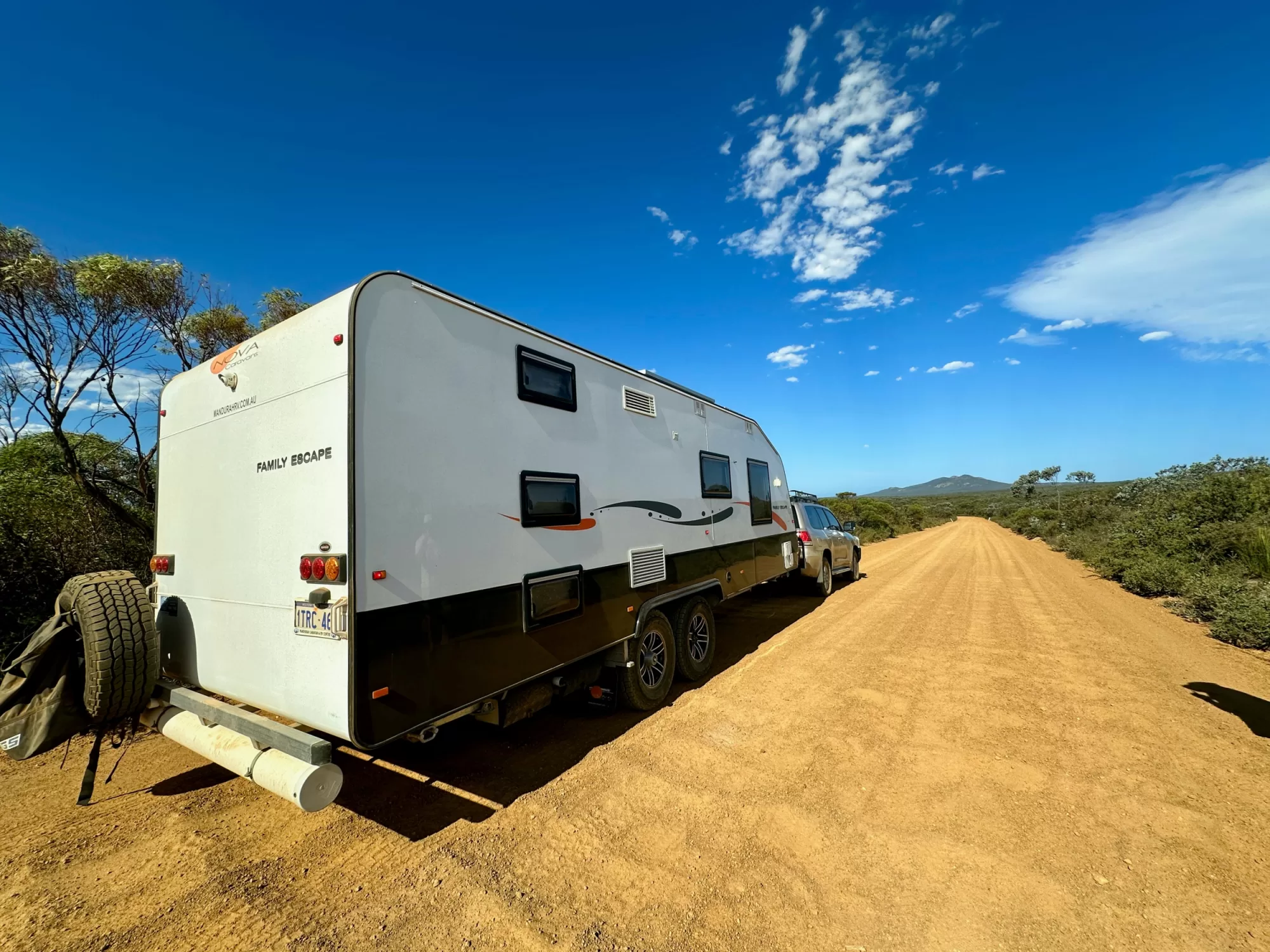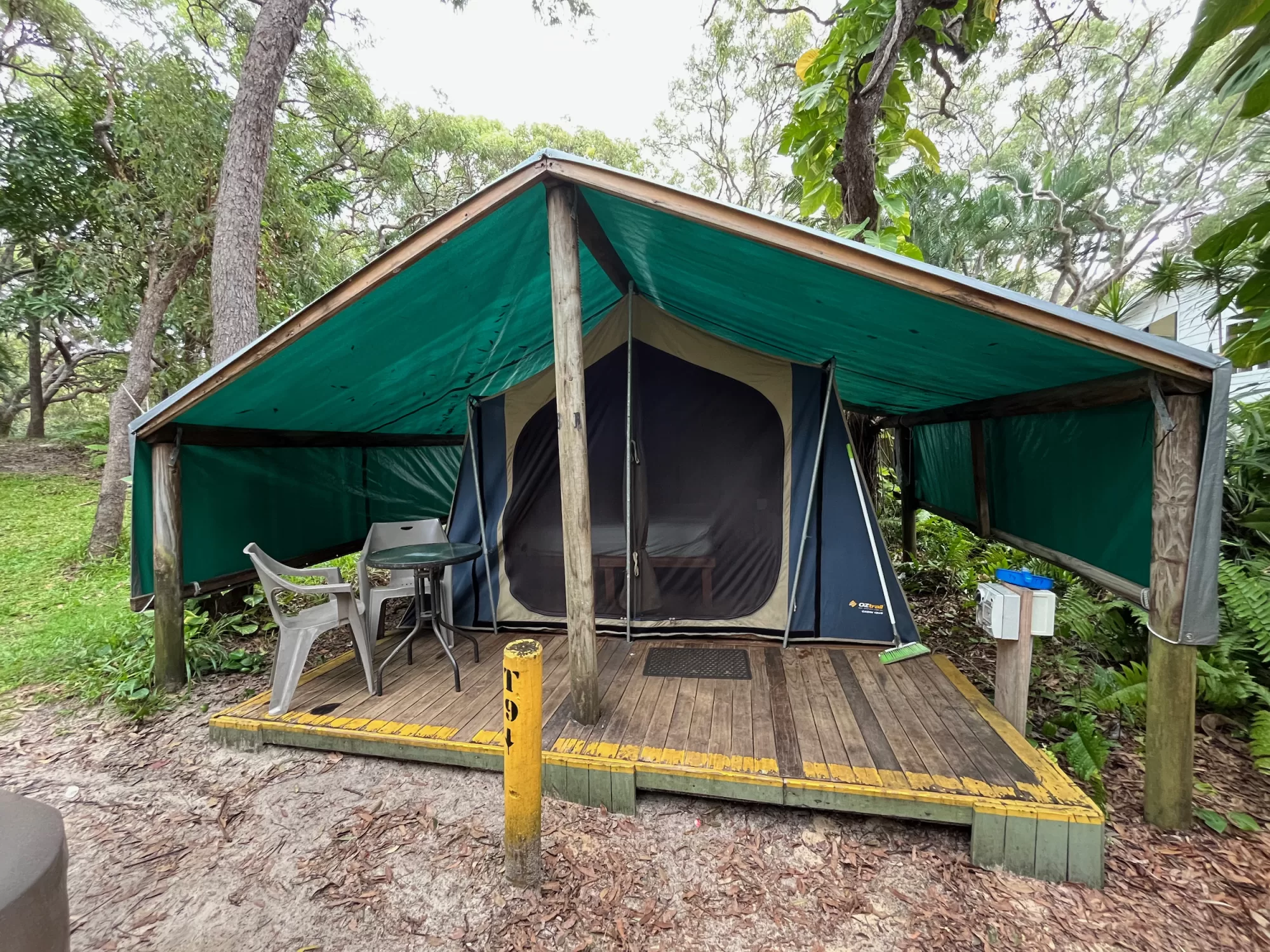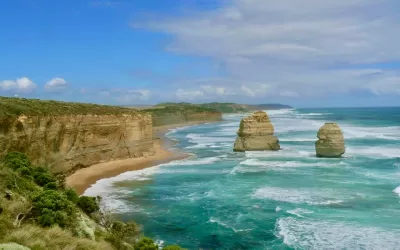Traveling around Australia with a caravan is an incredible adventure, filled with stunning landscapes, unique wildlife, and unforgettable experiences. As a family who spent a year exploring the vast and varied regions of Australia with our trusty caravan and an energetic toddler, we’ve experienced a wide range of types of accommodation. From luxurious caravan parks to rustic-free campsites, each type of accommodation has its charm and benefits. Here’s our detailed guide to the best accommodation options while caravanning in Australia, with tips for finding pet-friendly and kid-friendly spots, cost-saving strategies, and some unique experiences we had along the way.

Caravan Parks: A Home Away from Home
Caravan parks are the go-to option for many caravanners. They offer a range of facilities that make life on the road more comfortable and convenient. However, they are the most expensive option as well.
Features and Facilities:
Powered and Unpowered Sites:
Most caravan parks offer both powered and unpowered sites. Powered sites provide electricity for your caravan, while unpowered sites are usually more affordable and closer to nature.
Amenities:
Showers, toilets, and laundry facilities are standard. Many parks also offer BBQ areas, camp kitchens, dump points, swimming pools, playgrounds, mini-golf courses, kayak or bicycle hire, or even outside cinema.
WiFi and TV Rooms:
For those who need to stay connected or entertain the kids, some parks provide WiFi access, TV rooms, DVD hire, or book swap.
Pet-Friendly Options:
Many caravan parks welcome pets, but it’s always best to check in advance. Some even have dedicated pet areas or dog-walking trails.
Other extras:
Some of the caravan parks offer after-hours check-in options as well, so it is better to ring them up and ask before you give up on making it in time. Often you can also purchase basic things such as Ice, Milk, and Sunscreen at the reception.
Price Range and booking:
Prices for caravan parks vary depending on the location and season. Expect to pay an average between $25 and $60 per night (even $83 during peak season) for a powered site. Memberships with networks like BIG4, Discovery Parks, NRMA, G’day, or RAC can provide discounts and other perks.
Booking is advised, especially during peak seasons. Also, consider making a booking in advance in case you are heading to more remote areas without coverage, you can make your booking online or via phone, it saves you the stress when finding out it’s fully booked upon arrival.
Usual Check-In and Check-Out Times
Understanding check-in and check-out times is crucial for planning your travels.
Check-In Times:
Most caravan parks and campgrounds have check-in times between 12 PM and 2 PM. Always check with the specific site for their policies.
Check-Out Times:
Check-out times are typically between 10 AM and 11 AM. Late check-outs may be available for an additional fee.
Our Experience:
We stayed at numerous caravan parks, and they were particularly handy when we needed to recharge our batteries (both literally and figuratively). Nikolas loved the playgrounds and pools, and we appreciated the more relaxed time where you don’t need to search for places to stay overnight, worry about recharging your battery or filling up your water as well as the friendly community atmosphere, oftentimes advising on great spots to visit.

Campgrounds: Embrace the Outdoors
Campgrounds offer a more rustic and natural experience, often situated in national parks, state forests, or other scenic areas.
Features and Facilities:
Basic Amenities:
Expect basic facilities such as toilets and water taps (not always potable). Some campgrounds also have showers, picnic tables, and fire pits.
Natural Settings:
These sites are often located in beautiful natural areas, providing a peaceful and serene environment. They might require a 4WD vehicle though, so always check beforehand.
Advanced Bookings:
Popular campgrounds may require advance bookings, especially during peak seasons.
Price Range:
Campground fees can range from free to around $30 per night. National park campgrounds usually charge a small fee, which goes towards park maintenance and conservation.
Our Experience:
We loved the campgrounds for their proximity to nature. Waking up to the sounds of birds and the sight of kangaroos hopping by was magical. One of our favorite spots was in the Grampians National Park, where we had an unforgettable time of hiking and wildlife watching.
Free Campsites: Budget-Friendly Adventures
Free campsites are a fantastic option for those looking to save money and enjoy more remote locations.
Features and Facilities:
Limited Facilities:
Free campsites often have minimal facilities, such as a basic toilet or a water tap. Some may have nothing at all.
Remote Locations:
These sites are usually in more remote and less crowded areas, offering a true off-the-grid experience.
Local Regulations:
Always research local regulations and guidelines for free camping. Some areas have restrictions or require permits.
Price Range:
As the name suggests, these campsites are free to use. However, it’s good practice to support local communities by purchasing supplies or making a donation if there’s an honesty box.
Our Experience:
Free campsites gave us the chance to experience some of Australia’s most beautiful and untouched landscapes. We often find these sites through apps like WikiCamps or CamperMate, which provide detailed information and user reviews.
Top tip: always read the reviews before departure, they may tell you useful information about noise at night, safety, permanent living there, etc.

Alternative Accommodations: Unique and Memorable
In addition to traditional caravan parks and campgrounds, there are several alternative accommodation options that offer unique experiences.
Farm Stays:
Features:
Farm stays allow you to park your caravan on a working farm. Activities might include animal feeding, farm tours, and sometimes access to farm-fresh produce.
Price Range:
Prices vary but are generally affordable, ranging from $20 to $50 per night.
Our Experience:
We stayed at a delightful Olive farm in Margaret River where our toddler could run around surrounded by nothing but olive trees and we had the most spectacular sunsets there.
Private Properties:
Features:
Websites (or apps) like Hipcamp or Airbnb list private properties that welcome caravans. These can range from driveways to large estates.
Price Range:
Prices can vary widely depending on the location and facilities offered.
Pet-Friendly Accommodations: Traveling with Furry Friends
Traveling with pets adds another layer of consideration when choosing accommodation. Fortunately, many caravan parks and campgrounds are pet-friendly.
Pet-Friendly Features:
Designated Pet Areas:
Some parks have specific areas for pets, including off-leash areas and dog-walking trails.
Pet-Friendly Cabins:
For those times when you need a break from the caravan, some parks offer pet-friendly cabins.
Rules and Regulations:
Always check the rules regarding pets. Some places have restrictions on the number or size of pets, and pets may not be allowed in certain areas like communal kitchens or swimming pools.

Kids-Friendly Accommodations: Fun for the Little Ones
Traveling with a toddler means finding accommodations that are kid-friendly. Look for parks and campgrounds that offer amenities and activities to keep the little ones entertained, it gives you a breather and your bud will be over the moon with a jumping pillow or swimming pool just behind the caravan.
Kids-Friendly Features:
Facilities:
Some caravan parks offer family rooms with private baths or showers, which is great, especially for families with more kids.
Playgrounds:
Many caravan parks have playgrounds with slides, swings, jumping pillows, and climbing frames.
Swimming Pools:
Pools are a great way for kids to cool off and have fun. Caravan parks like Big 4 even have water slides and a lot of splashing fun.
Kids’ Clubs and others:
Some parks offer kids’ clubs with organized activities and games. Others bike, e-bike, or kayak hire, movie nights, or game rooms.
Our Experience:
Our toddler loved the playgrounds and pools. BIG4, NRMA, and Discovery Parks were consistently great for kid-friendly amenities, and we found that the staff were always accommodating and understanding of young families’ needs.
Cost-Saving Tips for Accommodation
Traveling for a year means finding ways to stretch your budget. Here are some of our top tips for saving on accommodation:
Join Membership Programs:
Networks like BIG4, Discovery Parks, NRMA, G’day, or RAC offer memberships that provide discounts on accommodation and other benefits.
Use Apps:
Apps like WikiCamps, CamperMate, and HipCamp are invaluable for finding affordable campsites and free camping spots.
Travel Off-Peak:
Traveling during off-peak seasons can save you a significant amount on accommodation fees.
Book in Advance:
Secure better rates and ensure availability by booking in advance, especially during peak seasons and holidays.

Driveway Sharing:
Websites and apps offer opportunities to park on private driveways for a small fee, providing a safe and inexpensive option for overnight stays, find dedicated groups on Facebook.
Free Camping and rest areas with permitted overnight stay: The Ultimate Budget Option
Free camping is an excellent way to save money and enjoy some of Australia’s most remote and beautiful locations.
How It Works:
Free campsites are typically located on public land or in areas where camping is permitted without a fee. Facilities are minimal, so be prepared to be self-sufficient.
Rest areas are usually next to the highway so expect more traffic, limited space, noise, and usually only toilets and picnic tables, if any.
Top tip: make sure to arrive early (well before the sun sets) to secure your spot.
Finding Free Campsites:
Use apps like WikiCamps or CamperMate to find and review free campsites. These apps provide user-generated reviews, photos, and information about facilities and access.
Top tip: always read the reviews before departure, they may tell you useful information about noise at night, safety, permanent living there, etc.
Our Experience:
We discovered some amazing free campsites while crossing the Nullarbor. The lack of facilities was more than compensated by the stunning view and the sense of adventure.

Fire Bans and Rules
Australia’s climate can be hot and dry, leading to fire bans in many areas.
Fire Bans:
During high-risk periods, fire bans may be in place. This means no open fires, including campfires and BBQs, in certain areas.
Rules:
Always check local fire regulations and adhere to them strictly. Fines for breaching fire bans can be severe.
Honesty Boxes: A Trust-Based System
Some campsites, particularly free or low-cost ones, use honesty boxes for payment.
How They Work:
These sites operate on a trust system, where you deposit your fee in a box. This helps maintain the site and shows respect for the facilities provided.
Our Experience:
We encountered honesty boxes at several sites and always appreciated the opportunity to contribute to the upkeep of these beautiful spots. The prices were usually around $10-$20 per night, oftentimes in 4WD access areas, however, we never met a ranger who would knock on our doors, but the word has it they do exist.
Camping on the Beach: A Unique Experience
Australia’s coastline offers numerous opportunities for beach camping.
Where to Camp:
Many coastal areas permit beach camping, but it’s essential to check local regulations and obtain any necessary permits.
Tips:
Be mindful of tides and weather conditions. Set up camp above the high tide line and be prepared for changing conditions.
Make sure you have a 4WD vehicle and you know how to drive in soft and hard sand.
Secure proper gear to get out if you get bogged (recovery tracks, shovel, etc.)
Our Experience:
Camping on the beach was one of our favorite experiences. We camped at Rye on the Mornington peninsula, where we enjoyed stunning sunsets, fishing, and beachcombing right from our doorstep.

Camping in National Parks: Natural Beauty
National parks are fantastic places to camp, offering well-maintained sites and beautiful natural surroundings.
Booking and Fees:
Many national parks require advance booking and charge a small fee. The funds go towards park maintenance and conservation efforts.
Facilities:
Facilities in national park campgrounds vary but typically include toilets, picnic areas, and sometimes showers.
Our Experience:
We camped in several national parks. The campsites were well-maintained and offered easy access to hiking trails and scenic viewpoints.
Related Facebook Groups: Community Support
Joining related Facebook groups can provide valuable tips, support, and a sense of community.
Popular Groups:
Groups like “Caravanning Australia” and “Camping and Caravanning with Kids”, “Free Camping Australia” offer a wealth of information and a place to connect with other travelers.
Our Experience:
We found these groups incredibly helpful for advice on free camping spots and breathtaking hidden gems like pristine clear swimming holes.
Caravan Park Groups and Discounts
Many caravan parks are part of larger networks that offer discounts and benefits to members.
Membership Benefits:
Networks like BIG4, Top Parks, and Discovery Parks offer loyalty programs that provide discounts on accommodation, access to exclusive deals, and other perks.

Top tip:
Check out a caravan park of each network and find your favorite, Join these programs and you will find the discounts adding up quickly, especially during longer stays and peak seasons. The membership also gives you access to high-quality facilities and a consistent standard of service. We enjoy staying at NRMA Caravan parks, because Nikolas simply loves their jumping pillow and swimming pools, and we appreciate the high standard versus reasonable price combination.
Bonus Tips: Finding Last-Minute Accommodation
Sometimes, finding a place to stay at the last minute can be challenging. Here are some bonus tips:
Showgrounds and Sports grounds:
Many towns allow caravans to park overnight at showgrounds or sports grounds for a small fee. These sites often have basic facilities like toilets and water.
Sport Clubs:
Some sports clubs, such as local football or cricket clubs, offer parking for caravans. This can be a safe and inexpensive option, as a bonus there are usually great dining options or even raffles.
Our Experience:
We used showgrounds and sportgrounds several times, especially during peak seasons when other sites were full. They provided a convenient and affordable solution. In addition, you may find also water or dump point located nearby, which comes in very handy.
Stealth Camping: A Different Kind of Adventure
There is a term called stealth camping that involves parking overnight in areas not designated for camping, such as quiet residential streets or industrial areas. Now this is not to encourage this activity but to inform about its existence. Travelers using this kind of camping are usually young people living on a strict budget driving a van (that can be easily disguised).
Tips for Stealth Camping:
If you are tired, out of options and you must use this kind of overnight stay:
Be Discreet:
Arrive late and leave early to avoid drawing attention.
Leave No Trace:
Respect the area and ensure you leave it as clean as you found it.
Research Local Regulations:
Some areas have strict rules against overnight parking, so always check local regulations to avoid fines.

Evaluation of Price and Facility Combination
When evaluating the price and facility combination for caravanning accommodation, it’s essential to balance your budget with your needs and preferences.
Caravan parks are undoubtedly the most convenient and luxurious option, offering comprehensive facilities such as showers, toilets, laundry, swimming pools, and recreational areas. However, they also come with the highest price tag, often ranging from $25 to $60 (even $80 during peak times) per night.
For families looking to maintain a balance between comfort and cost, a mixed approach can be highly effective. By spending a few nights in caravan parks to take advantage of amenities like laundry services, water refills, and battery charging, and then switching to free or low-budget campgrounds, you can significantly reduce your overall expenses.
Free campsites, although lacking in facilities, provide a budget-friendly alternative that allows you to immerse yourself in nature. If you’re equipped with solar panels, a generator, large water tanks, and a DIY spirit for laundry and other needs, you can comfortably enjoy off-grid living. This dirt-cheap approach not only saves money but also offers a unique and rewarding experience of Australia’s pristine landscapes.
Ultimately, the best strategy is to tailor your accommodation choices to your specific needs, mixing and matching to enjoy both comfort and savings during your caravanning adventure.
Conclusion: Embrace the Journey
Traveling around Australia in a caravan with a toddler is an incredible adventure filled with challenges and rewards. By exploring the various accommodation options and utilizing cost-saving strategies, you can make the most of your journey. Whether you’re staying in a luxurious caravan park, a remote free campsite, or a friendly farm stay, the key is to remain flexible and open to new experiences. Happy travels, and enjoy every moment of your caravanning adventure!
Take a look at our Australia Travel Guide page for all the inspiration and information you need to kickstart your travels and hit the road more frequently!






0 Comments